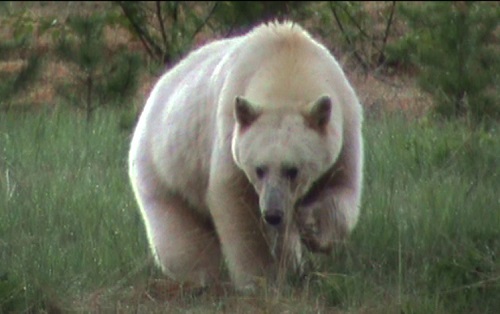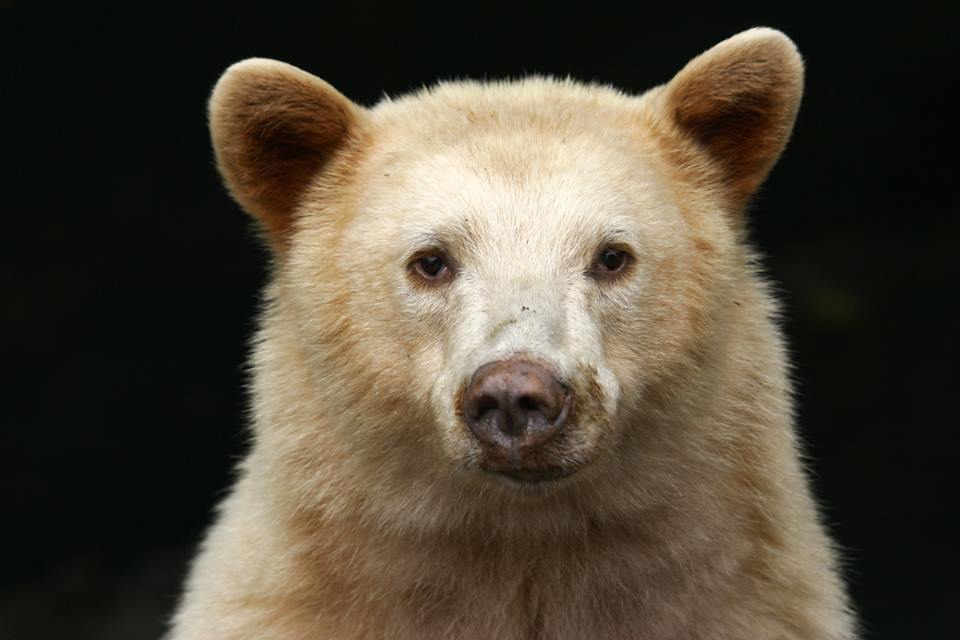When you think of a white bear, you're probably imagining the iconic, formidable, and sadly, endangered polar bear, roaming the frozen plains at the top of the globe. After all, white fur in an all-white climate makes sense. Although to be technical, a polar bear's fur is transparent, and only appears white because it reflects the light.
So you might not expect to find a white bear in the middle of the rich green forests of British Columbia in Canada. But in fact, there's an entire population of elusive white bears living in these beautiful forests.
And they don't have albinism. As weird as it sounds, they're actually white-furred black bears!
The indigenous peoples of the area called these bears "spirit bears" and held them especially sacred due to their shy, elusive nature.
Even though a black or brown bear might be better camouflaged, seeing a white bear was very rare. Their white fur is the result of a genetic anomaly, so they're not common.
Bears have long fascinated people. They're so adorable, but very dangerous! Many species of bear, like the Andean bear, are also threatened by human activities, and need protection.
Read on to learn more about this ghostly bear!
[H/T: Twisted Sifter, Smithsonian, BC Spirit Bear]

Spirit bears, technically named Kermode bears, live in the mountainous, forested region of British Columbia's northern coast.
This beautiful landscape is home to many animals that appear in First Nation lore, including salmon, owls, and ravens.
All of these animals are honored by First Nations people, but the spirit bear holds a special place for them.

Spirit bears are actually a very rare subspecies of American black bear.
Of black bears, about a tenth of them have creamy white fur. There are less than 400 spirit bears between Southern Alaska and Vancouver Island.
It's not albinism, though, nor are they related to polar bears. Their light color comes from a unique recessive gene that only appears in this subspecies.

Because white fur is a recessive gene, it's possible for a black-furred mother bear to give birth to a white cub.
Like other black bears, spirit bears are tiny when they're born, weighing only half a pound! But they get big — really big.
Males can weigh up to 500 pounds as adults, and females can reach 300. On their hind legs, they stand nearly six feet, and they can run fast.

Most white-colored animals have a tough time because it's harder for them to camouflage themselves, so they're obvious to predators and prey alike.
But the spirit bear's white fur actually gives it an advantage when fishing for salmon.
During the day, it's harder for the fish to see a light-colored bear against the light sky, and so spirit bears are actually more successful at catching salmon during the day than their black-furred friends.

The native Kitasoo say that bears and humans are closer than you might think, and that it was the bears who taught humans how to gather berries and fish for salmon.
They also say that bears can take human form.

The spirit bears are also helping unite First Nations activists and communities, scientists, researchers, and conservationists in the region.
Together, they're working to preserve British Columbia's precious rainforests, and all of the creatures who call it home — including humans.

Researchers set up "hair traps" in the woods to study the bears, their movements, and their numbers.
The hair traps are baited with yummy-smelling (to a bear) scents like vanilla, berries, and beaver musk, and they gently snag some fur as the bear investigates. The bears are also videotaped.
The DNA from the hair is then catalogued, so scientists can identify the bears individually.

Spirit bears are very rare because of their recessive gene. Both parents have to be carriers in order for the white fur to manifest.
And due to human interference on land and in the waters, the bears are even more threatened.
That's why it's so important to make sure this habitat stays healthy for years to come.

Spirit bears are a beautiful secret hidden deep in the forests, and they remind us just how magical nature really is.
You can learn more about these bears and what's being done to keep their habitat safe from the Spirit Bear Research Foundation
If you think these beautiful bears need to be protected, please SHARE this beautiful bear with anyone who loves nature!




